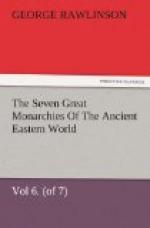There is much doubt as to the time at which Volagases I. ceased to reign. The classical writers give no indication of the death of any Parthian king between the year A.D. 51, when they record the demise of Vonones II., and about the year A.D. 90, when they speak of a certain Pacorus as occupying the throne. Moreover, during this interval, whenever they have occasion to mention the reigning Parthian monarch, they always give him the name of Volagases. Hence it has been customary among writers on Parthian history to assign to Volagases I. the entire period between A.D. 51 and A.D. 90—a space of thirty-nine years. Recently, however, the study of the Parthian coins has shown absolutely that Pacorus began to reign at least as early as A.D. 78, while it has raised a suspicion that the space between A.D. 51 and A.D. 78 was shared between two kings, one of whom reigned from A.D. 51 to about A.D. 62, and the other from about A.D. 62 to A.D. 78. It has been proposed to call these kings respectively Volagases I. and Artabanus IV. or Volagases I. and Volagases II., and Parthian history has been written on this basis; but it is confessed that the entire absence of any intimation by the classical writers that there was any change of monarch in this space, or that the Volagases of whom they speak as a contemporary of Vespasian was any other than the adversary of Corbulo, is a very great difficulty in the way of this view being accepted; and it is suggested that the two kings which the coins indicate may have been contemporary monarchs reigning in different parts of Parthia. To such a theory there can be no objection. The Parthian coins distinctly show the existence under the later Arsacidae of numerous pretenders, or rivals to the true monarch, of whom we have no other trace. In the time of Volagases I. there was (we know) a revolt in Hyrcania, which was certainly not suppressed as late as A.D. 75. The king who has been called Artabanus IV. or Volagases II. may have maintained himself in this region, while Volagases I. continued to rule in the Western provinces and to be the only monarch known to the Romans and the Jews. If this be the true account of the matter, we may regard Volagases I. as having most probably reigned from A.D. 51 to about A.D. 78—a space of twenty-seven years.
CHAPTER XVII.
Results of the Establishment of Tiridates in Armenia. Long period of Peace between Parthia and Rome. Obscurity of Parthian History at this time. Relations of Volagases I. with Vespasian. Invasion of Western Asia by Alani. Death of Volagases I. and Character of his Reign. Accession and Long Reign of Pacorus. Relations of Pacorus with Decebalus of Dacia. Internal Condition of Parthia during his Reign. Death of Pacorus and Accession of Chosroes.




